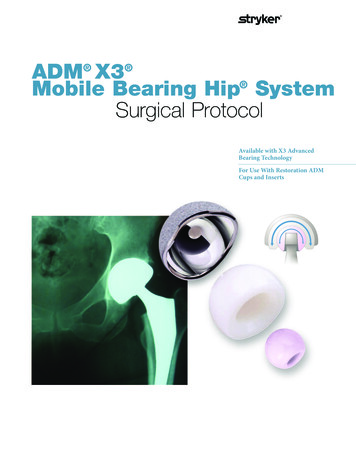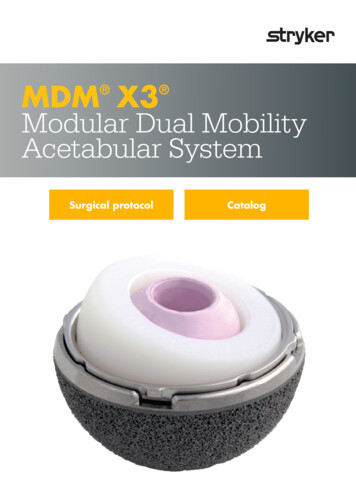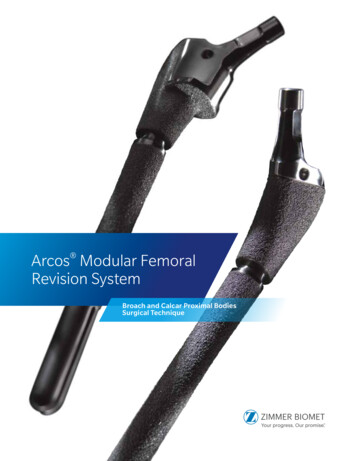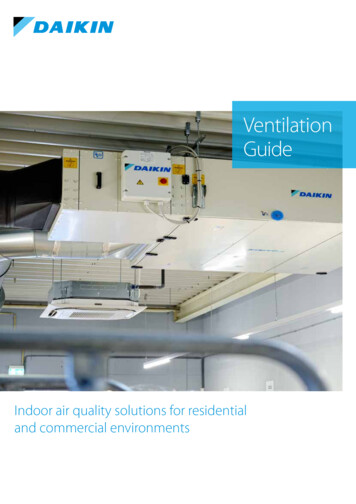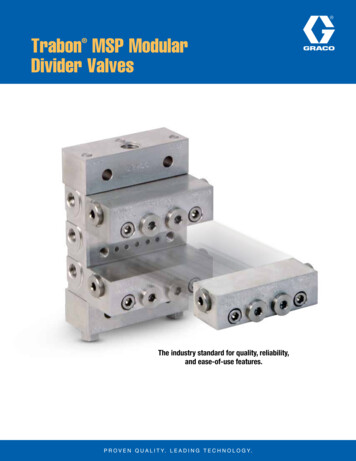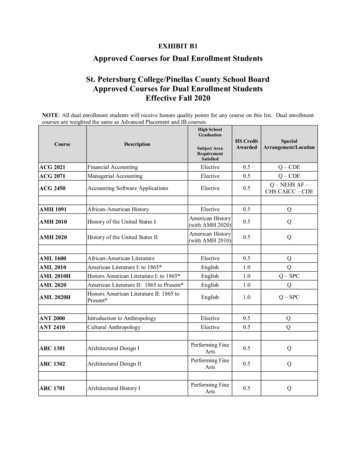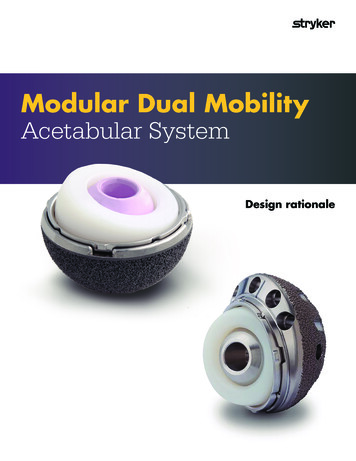
Transcription
Modular Dual MobilityAcetabular SystemDesign rationale
Modular Dual Mobility Acetabular System Design rationaleAddressinginstability withdual mobility.Worldwide patient outcomes areaffected by instability, which is asignificant complication of totalhip arthroplasty (THA)1.National joint registriesand meta-analyses indicate thathip dislocation is oneof the most common causesof THA failure in both primaryand revision procedures1-4. Thishas significant implicationsfor future revision burden in atime of increasing numbers ofTHA performed in increasinglyyounger patients1.Registry data shows thatdislocation is the second mostcommon reason for revisionsof primary hip procedures5 anddislocation rates range from4-30% in revision procedures3.The burden to the healtheconomic system is higher whenrevisions occur, with an averagelength of stay over 6 days andcost upwards of 54,000 in theUS6.Constructs such as constrainedliners and large femoral headswere designed to help addressdislocation due to instability,but have had limited successin decreasing the postoperativedislocation rates2. Dual mobilityconstructs were developed in the1970s, and have demonstratedsuccess in enhancing thestability of THAs1-4,7.2016 Australian Orthopaedic Association National Joint Replacement RegistryReason for esis .5Pain2201.8Leg Length 0Implant Breakage Stem1171.0Metal Related Pathology1040.9Wear Acetabular Insert960.8Implant Breakage Acetabular Insert920.8Implant Breakage Acetabular920.8Incorrect Sizing900.8Implant Breakage Head350.3Other2362.0Total11907100.0Reference: 52
Modular Dual Mobility Acetabular System Design rationaleModular DualMobilityTwo Points of ArticulationExternal (large)Stryker’s MDM consists of amodular cobalt chrome liner, alarge diameter X3 polyethyleneinsert, and a femoral head.The highly polished modularcobalt chrome liner can beassembled into any of Stryker’sacetabular shells utilizing theTrident Locking Mechanism. X3polyethylene has demonstratedannual in vivo wear of just1 micron at 5 years, withno mechanical failures withconventional bearings8.Together these componentsresult in a dual mobility devicewith two points of articulation –one between the X3 polyethyleneinsert and metal liner (externalbearing), and the other betweenthe X3 polyethylene insertand the femoral head (internalbearing). Primary motion occursat the inner bearing while theouter bearing moves in cases ofextreme range of motion, whichmay minimize wear9, reducefrictional torque7, and increasestability7.Internal (small)Clinical advantage of MDM:MDM offers stability2-3,7 with: Versatility Clinical proof1-4,10,11 Economic value123
Modular Dual Mobility Acetabular System Design rationaleStability: The X3 polyethylene inserts ofthe MDM system are availablein large sizes offeringincreased jump distance – thedistance the femoral headmust travel to dislocate1. Thegreater the jump distance,the greater the stability of thehip13. Computer simulations ofdislocation demonstrate thatfor a given shell size the MDMdesign surpasses the jumpheight of a traditional fixedbearing7,14. When compared to aconventional THA with a36mm femoral head, MDMoffers a 59% increase injump distance7,14.2-D Jump Height (left) and 3-D Posterior Horizontal Dislocation Distance: denoted X (center and right)7.Jump Distance (mm) measured at 26 of pelvic tilt with a 54mm shell at 45 of inclination and 20 of facingMeasured in 3D Posterior Horizontal Dislocation Distance; Reference: 7436mmhemi46mmMDM
Modular Dual Mobility Acetabular System Design rationaleVersatility:MDM is a versatile bearingoption, as its indications includeboth primary and revisioncases1-4. It is a simple constructto use as it does not require achange in surgical technique andmay be easily incorporated into asurgeon’s practice.MDM is versatile because it: May be used in primary andrevision procedures Utilizes the TridentInnerchange LockingMechanism, allowingsurgeons the flexibility totrial modular or fixed bearingoptions intraoperatively May be used with Trident II,Trident, Tritanium, or theRestoration Anatomic Shell Offers the option to usecancellous bone screwsPotential applications for MDMRevision:High risk primary:Primary: Dislocation Mental disability High demand patients Neuromuscular disease Acute femoral neck fracture Spinal fusions Dysplastic hips Small acetabulums5
Modular Dual Mobility Acetabular System Design rationaleClinical proof:MDM launched in 2011, and since has had several studies published to show clinical success ranging fromoutcome data on stability to metal ion levels.StabilityMDM has been shown to be clinically successful in preventing dislocations1-4.“The use of dual-mobility bearings in difficult hip arthroplasty reconstructive cases” – Mont et al. I n a revision setting, patients with dual mobility had lower dislocation and aseptic looseningrates compared to the control group2.“Dual-Mobility Constructs in Revision THA Reduced Dislocation, Re-Revision & ReoperationCompared to Large Femoral Heads” – Abdel et al. R evision THA patients with a dual mobility construct had a lower risk of subsequent dislocation, lower risk ofre-revision for dislocation, and lower risk of reoperation for any reason at 3.6 years of follow-up whencompared to patients treated with a 40mm femoral head4. S urgeons may consider expanding the role of dual mobility constructs in contemporary revision THAs as dualmobility constructs have shown to lower the risk of subsequent dislocation, re-revision, and reoperation4.“The use of dual-mobility bearings in difficult hip arthroplasty reconstructive cases” – Mont et al. M DM addressed stability in a wide array of indications, ranging from revisions to high risk primary procedures. A uthors of the study recommend the use of dual mobility in cases of recurrent dislocation, for revisionarthroplasties, or for patients at a high risk of dislocation in primary arthroplasty3.“Early experience with dual mobility acetabular systems featuring highly cross-linked polyethyleneliners for primary hip arthroplasty in patients under fifty five years of age: an internationalmulti-centre preliminary study” – Epinette et al. T he study evaluated dual mobility constructs in patients 55 years and younger, and concluded that MDMdemonstrated excellent clinical data and may reduce stability and wear in the long run1.ModularityModular junctions are a consideration with implant selection for reasons of strength, material performance, and corrosion.In fact, clinical studies have been shown to demonstrate that the modularity of the MDM liner, metal ions have been shownnot to be an issue10, and no difference has been shown in metal ion levels when compared to conventional constructs11.“Metal ion levels in patients with modular acetabular hip components, matching CrCo liners withtitanium cups” – Epinette, J. T his two year study demonstrated that modularity was not an issue with MDM, due to an optimal lockingmechanism design10.“What are normal metal ion levels after total hip arthroplasty? A serologic Analysis of Four BearingSurfaces” – Barlow et al. T his study compared metal ion levels between polyethylene with ceramic and metal heads, ceramic on ceramicand MDM with a ceramic of metal head, and showed that there was no difference in metal ion levels across allbearing options11.6
Modular Dual Mobility Acetabular System Design rationaleEconomic Value:MDM exhibited “absolute dominance” with cost effectiveness over conventional THA12.“Dual mobility implants are cost-saving for primary THA: A cost-utility analysis using direct andindirect costs” – Barlow et al. T his study compared outcomes of MDM and conventional constructs, along with costs associated with theimplants and the revisions12. M DM was shown to be more cost effective when compared to conventional constructs12.How may hospitals benefitwhen using MDM?How may surgeons benefitwhen using MDM?How may patients benefitwhen using MDM?A study has shown that hipinstability/dislocation andmechanical loosening arethe most common causes forrevision THAs in the US6. Forinstance, the cost of treatingdislocation has been estimated torepresent 74,000,000 annuallyto the U.S. healthcare system15.Prevention of issues such asdislocation and loosening afterhip arthroplasty is criticalnot only to minimize patientmorbidity but also to maintainthe cost-effectiveness of thissurgical procedure.MDM offers surgeons analternative solution foraddressing individual needsof patients. MDM is designedto offer orthopaedic surgeonsincreased versatility to allowthem to address the widebreadth of reconstructivechallenges that they face.MDM is designed to allow forthe potential for improved jointstability1-4. This bearing solutionmay be a suitable alternative forthe changing needs of patientswho require THA surgery –allowing surgeons to offerpatients a solution to maintaintheir activity and lifestyle.The MDM system has beendesigned to help address themost common reasons for failureafter THA1-4, which may help tominimize the overall expense tohospitals and the U.S. healthcaresystem.Operating Room Efficiency Single set of instrumentationto maximize OR efficiencySimplicity Surgical procedure is similarto conventional THAIntra-operative Versatility MDM uses a conventionalacetabular shell offering thesurgeon the intraoperativeflexibility to utilize aconventional design or theMDM System7
References:1.Epinette, J. et al. Early experience with dual mobility acetabular systems featuring highlycrosslinked polyethylene liners for primary hip arthroplasty in patients under fifty-five years ofage: an international multi-centre preliminary study. International orthopaedics (SICOT).Sept. 2016 DOI 10.1007/s00264-016-3367-0.2.Jauregui, J. et al. Dual mobility cups: an effective prosthesis in revision total hip arthroplastiesfor preventing dislocations. Hip Int. 2016 Feb 8;26(1):57-61. doi: 10.5301/ hipint.5000295.3.Mont, MA. et al. The Use of Dual-Mobility Bearings in Difficult Hip ArthroplastyReconstructive Cases. Surg Technol Int. 2011 Dec.; 21:234-40.4.Abdel, M., et al. Dual-Mobility Constructs in Revision THA Reduced Dislocation, Re-Revision &Reoperation Compared to Large Femoral Heads. Hip Society 2017 Otto Aufranc Award.5. Australian Orthopaedic Association National Joint Replacement Registry, 2016, page 6.Bozic, K, Kurtz, S, Lau, E, et al. The Epidemiology of Revision Total Hip Arthroplasty in theUnited States. JBJS. 2009. 91: 128-133.7.Heffernan, C., Bhimji, S.,Macintyre, J., et al. (2011). Development and Validation of a NovelModular Dual Mobility Hip Bearing. ORS Annual Meeting Poster #1165.8.Callary et al. Low Wear of a Second-generation Highly Crosslinked Polyethylene Liner: A 5 –yearRadiostereometric Analysis Study. CORR, 2013. 471:3596–3600.9.Herrera, L., Lee, R., Longaray, J., et al. (2010). Edge Loading Wear due to Inclination Angle forThree Contemporary Hip Bearings. 56th Annual ORS Meeting. Poster #2259.10. Epinette, J. et al. Metal ion levels in patients with modular acetabular hip components,matching CoCr liners with the titanium cups. Abstracts from 11th EHS Congress, StockholmSweden, 9-11 October 2014.11. Barlow, B., et al. What are normal metal ion levels after total hip arthroplasty? A serologicanalysis of four bearing surfaces. Journal of Arthroplasty. 2017; 1535-1542.12. Barlow, B., et al. Dual Mobility Implants Are Cost-Saving For Primary THA: A Cost-UtilityAnalysis Using Direct and Indirect Costs. J Bone Joint Surg Am. 2017;99:768-77.13. Philippot R, Camilleri JP, Boyer B, Adam P, Farizon F. The Use of a Dual-Articulation AcetabularCup System to Prevent Dislocation After Primary Total Hip Arthroplasty: Analysis of 384 Casesat a Mean Follow-Up of 15 Years. International Orthopaedics (SICOT) 2009; 33: 927-932.14. Stryker Test Report: RD-10-073. Range of motion and two and three dimensional jump distanceof the Modular Dual Mobility Insert. September, 2010.15. Sanchez-Sotelo J., et. al. Hospital Cost of Dislocation After Primary Total Hip Arthroplasty. JBJSAM 2006; 88: 290-294.325 Corporate DriveMahwah, NJ 07430t: 201.831.5000www.stryker.comA surgeon must always rely on his or her own professional clinical judgment when deciding whether to use a particular product when treating aparticular patient. Stryker does not dispense medical advice and recommends that surgeons be trained in the use of any particular product beforeusing it in surgery.The information presented is intended to demonstrate the breadth of Stryker’s product offerings. A surgeon must always refer to the packageinsert, product label and/or instructions for use before using any of Stryker’s products. Products may not be available in all markets becauseproduct availability is subject to the regulatory and/or medical practices in individual markets. Please contact your sales representative if youhave questions about the availability of any of Stryker’s products in your area. Stryker Corporation or its divisions or other corporate affiliatedentities own, use or have applied for the following trademarks or service marks: MDM, Restoration, Stryker, Trident, Tritanium, X3. All othertrademarksare trademarks of their respective owners or holders.MDM-BRO-2 Rev-1 21686 Copyright 2019 Stryker.
The MDM system has been designed to help address the most common reasons for failure after THA1-4, which may help to minimize the overall expense to hospitals and the U.S. healthcare system. How may surgeons benefit when using MDM? MDM offers surgeons an alternative solution for addressing individual needs of patients. MDM is designed
